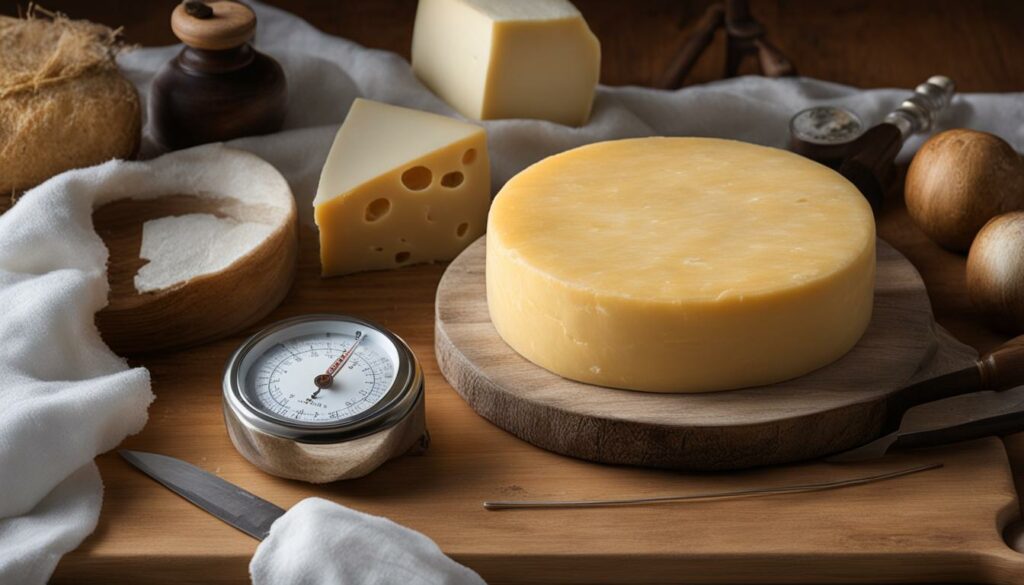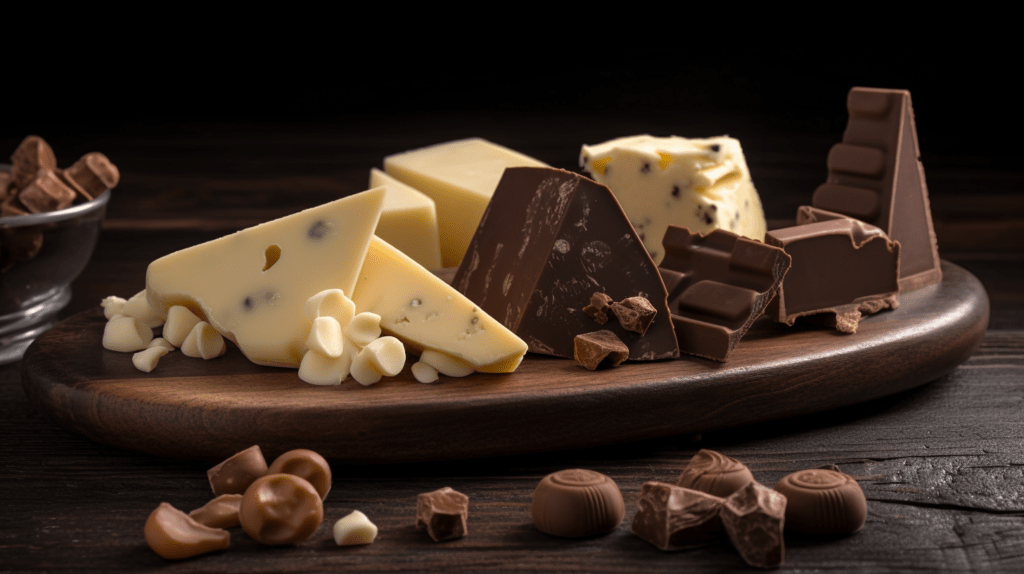Welcome to our comprehensive guide on Queso Fresco (Adobera) cheese, a beloved Mexican cheese with a rich history and delicious flavor. Whether you’re already a fan or new to this traditional Mexican cheese, we invite you to explore its many varieties and discover exciting recipes that showcase its versatility.
Queso Fresco (Adobera) cheese is a type of fresh, white, and soft cheese that has been a cherished ingredient in Mexican cuisine for centuries. Its origins can be traced back to the Spanish colonizers who introduced cheesemaking to Mexico. Known for its mild flavor and creamy texture, Queso Fresco (Adobera) cheese adds a delightful touch to a wide range of dishes.
In this guide, we’ll delve into the history of cheese in Mexico, from the prehispanic diet of indigenous inhabitants to the influence of the Spaniards on post-Hispanic and modern-day Mexican cuisine. You’ll learn about the various types of Mexican cheeses, with a specific focus on Queso Fresco (Adobera) cheese and its unique characteristics.
To help you make the most of this delicious cheese, we’ll also provide you with mouthwatering recipes that highlight its flavors. From enchiladas and salads to soups and grilled sandwiches, there’s no shortage of ways to incorporate Queso Fresco (Adobera) cheese into your favorite meals.
So join us on this culinary journey as we explore the world of Queso Fresco (Adobera) cheese. Whether you’re inspired by its rich heritage, seeking to expand your culinary horizons, or simply looking for new recipe ideas, this guide has something for you. Get ready to savor the authentic flavors of this traditional Mexican cheese!
The History of Cheese in Mexico – The Prehispanic Diet
Before the Spanish colonizers introduced cheese to Mexico, the prehispanic diet of indigenous inhabitants primarily consisted of grains, root vegetables, fruit, and the triad of corn, beans, and squash.
Meat was a rare protein source, and insects played a vital role in their diet. Domesticated protein sources were limited to turkeys and dogs raised for consumption by the ruling classes.
Although dairy products were not a part of the prehispanic diet, the indigenous inhabitants of Mexico had a rich cultural heritage of plant-based foods. Corn, beans, and squash formed the foundation of their meals, providing a balanced combination of carbohydrates, proteins, and essential nutrients.
Insects, such as grasshoppers, worms, and ants, were not only nutritious but also considered a delicacy.
The prehispanic diet is an important aspect of Mexican cuisine, showcasing the resourcefulness and creativity of the indigenous communities in utilizing the natural bounty of their surroundings.
Insects: A Protein Source
Insects were a significant protein source in the prehispanic diet and continue to be consumed in various regions of Mexico to this day. They are rich in nutrients and minerals, making them an integral part of traditional Mexican cuisine.
Today, various insects like chapulines (grasshoppers), gusanos de maguey (maguey worms), and hormigas chicatanas (ant eggs) are valued for their distinct flavors and nutritional benefits.
Impact of the Prehispanic Diet on Mexican Cuisine
The prehispanic diet laid the foundation for the diverse and vibrant flavors of Mexican cuisine. The indigenous inhabitants’ reliance on locally available ingredients and their innovative culinary techniques continue to influence traditional Mexican dishes.
The triad of corn, beans, and squash, known as “the three sisters,” remains a staple in Mexican cooking. These ingredients are not only nutritious but also form the base for dishes like tamales, tortillas, and pozole.
The prehispanic diet’s emphasis on plant-based foods and sustainable protein sources offers inspiration for modern-day chefs and individuals seeking to explore the rich culinary heritage of Mexico.
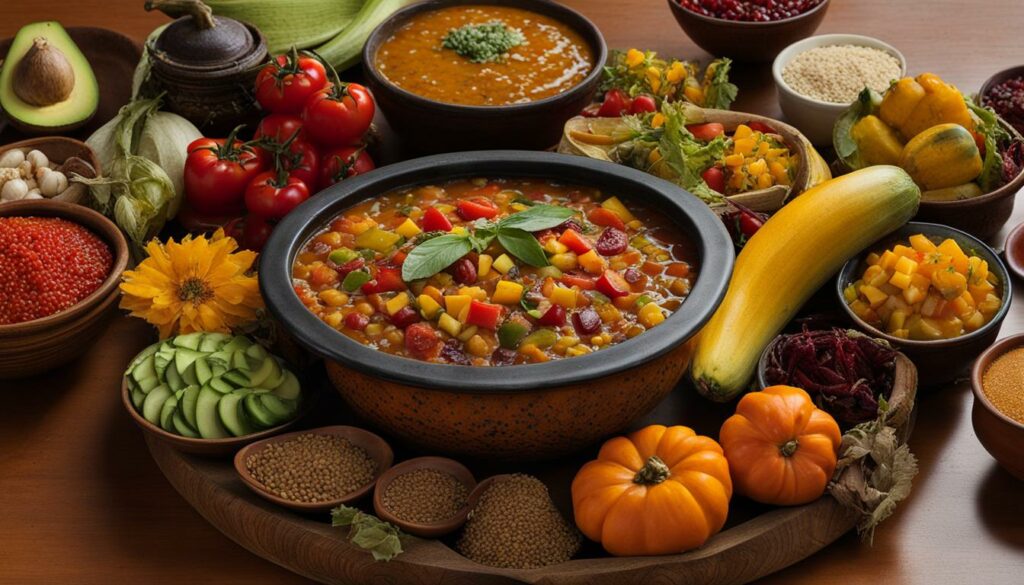
The History of Cheese in Mexico – Post-Hispanic and Modern-Day Mexican Cuisine
After the Spanish conquest, the introduction of livestock by the Spaniards significantly impacted the ecology, indigenous populations, and Mexican cuisine. The Spaniards brought with them various livestock, including cows, sheep, and goats, which greatly influenced the availability of dairy products in the region.
The indigenous populations quickly adapted to the presence of these animals and began incorporating milk into their diet. This led to the emergence of a vibrant cheesemaking tradition in Mexico, as these populations learned the art of cheese production from the Spaniards.
The cheesemaking tradition in Mexico flourished over the years, with different regions developing their unique styles and varieties of cheese. Today, Mexico is known for its diverse and flavorful cheeses that are deeply rooted in its cultural heritage.
Mexican markets, reminiscent of those described by early Spanish settlers, continue to be a vital hub for showcasing and selling these unique cheeses. Visitors to Mexican markets can explore a wide array of dairy products, including various artisanal cheeses that reflect the rich cheesemaking tradition of the country.
A Proud Tradition of Unique Cheeses
“Mexican cheesemakers have inherited the knowledge passed down through generations, carefully preserving the traditional methods while adding their own creative twists. This dedication to craftsmanship results in a wide range of unique cheeses with distinct flavors and textures.”
The unique cheeses of Mexico are the product of meticulous dedication and craftsmanship. From the crumbly and salty Cotija Cheese to the smooth and creamy Oaxaca Cheese, each variety offers a taste experience like no other. These cheeses have become an integral part of Mexican cuisine, adding depth and character to an array of dishes.
One standout cheese in Mexican gastronomy is Queso Fresco. This soft, fresh cheese has a mild flavor and crumbly texture, making it a versatile ingredient in various dishes. Whether crumbled over tacos or used as a filling in enchiladas, Queso Fresco adds a delightful touch to Mexican meals.
Another noteworthy cheese is Panela Cheese, known for its squeaky texture and ability to hold its shape when heated. This versatile cheese is popular in both savory and sweet preparations, making it a favorite among chefs and home cooks alike.
Furthermore, Mexican markets showcase regional cheeses that highlight the diversity and richness of Mexican culinary traditions. From the tangy and creamy cheeses of Oaxaca to the smoky and bold flavors of Chihuahua Cheese, there is something to satisfy every palate.
Image:
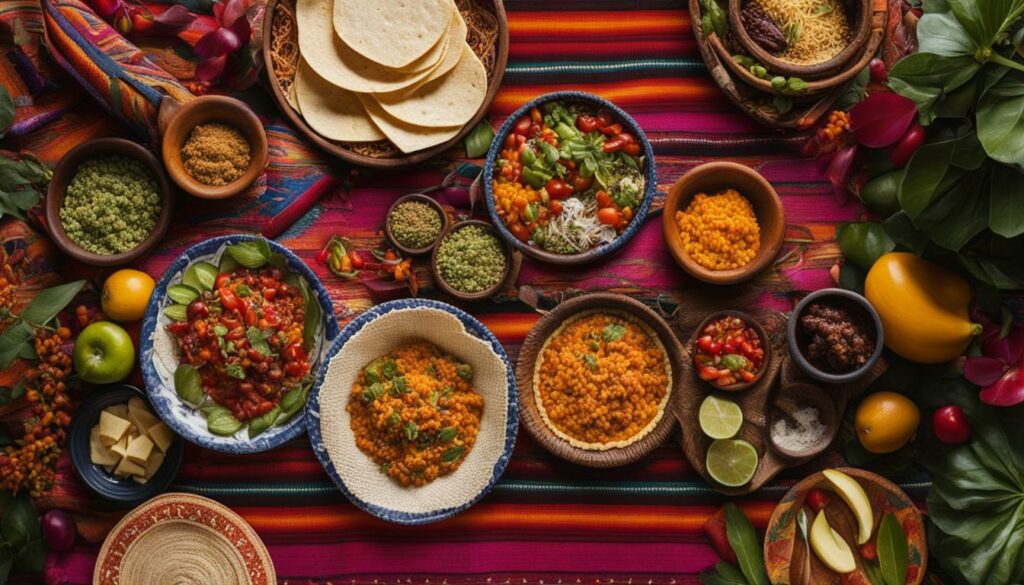
Fresh Mexican Cheeses (Soft to Semi-Firm)
When it comes to the diverse world of Mexican cheeses, the fresh varieties stand out for their mild flavor and a range of textures, from soft to semi-firm. These cheeses add a delightful touch to any Mexican dish, whether it’s a vibrant salad, a comforting bowl of soup, or an indulgent enchilada.
Here are some of the most commonly available fresh Mexican cheeses:
- Queso Fresco: A crumbly and slightly salty cheese that is perfect for crumbling over salads or as a filling for enchiladas.
- Queso Blanco: This creamy and mild cheese is versatile and can be used in a variety of dishes, from tacos to quesadillas.
- Panela Cheese: With its firm texture and buttery flavor, panela cheese is often sliced and grilled to add a deliciously melty element to dishes.
- Tenate Cheese: A semi-soft cheese with a slightly tangy taste, tenate cheese is a popular choice for stuffing chiles or adding to salsas.
- Adobera Cheese: This cheese has a creamy, spreadable texture and a mild flavor that pairs well with spicy dishes.
- Requesón: Similar to ricotta cheese, requesón is creamy and fluffy, making it perfect for desserts or as a spread on tostadas.
- Crema Mexicana: A rich and tangy Mexican cream that is often used as a topping for tacos, enchiladas, and soups.
These fresh Mexican cheeses can be found in most grocery stores or specialty Mexican markets. They offer a taste of authentic Mexican cuisine and are a must-have for any home cook looking to explore the flavors of Mexico.
| Cheese | Texture | Flavor | Common Uses |
|---|---|---|---|
| Queso Fresco | Crumbly | Salty | Topping, filling for enchiladas |
| Queso Blanco | Creamy | Mild | Tacos, quesadillas |
| Panela Cheese | Firm | Buttery | Sliced and grilled |
| Tenate Cheese | Semi-soft | Tangy | Stuffing chiles, adding to salsas |
| Adobera Cheese | Creamy | Mild | Pairing with spicy dishes |
| Requesón | Fluffy | Creamy | Desserts, spread on tostadas |
| Crema Mexicana | Smooth | Tangy | Topping for tacos, enchiladas, and soups |
Next, let’s explore the world of Mexican melting cheeses and discover their melty goodness.
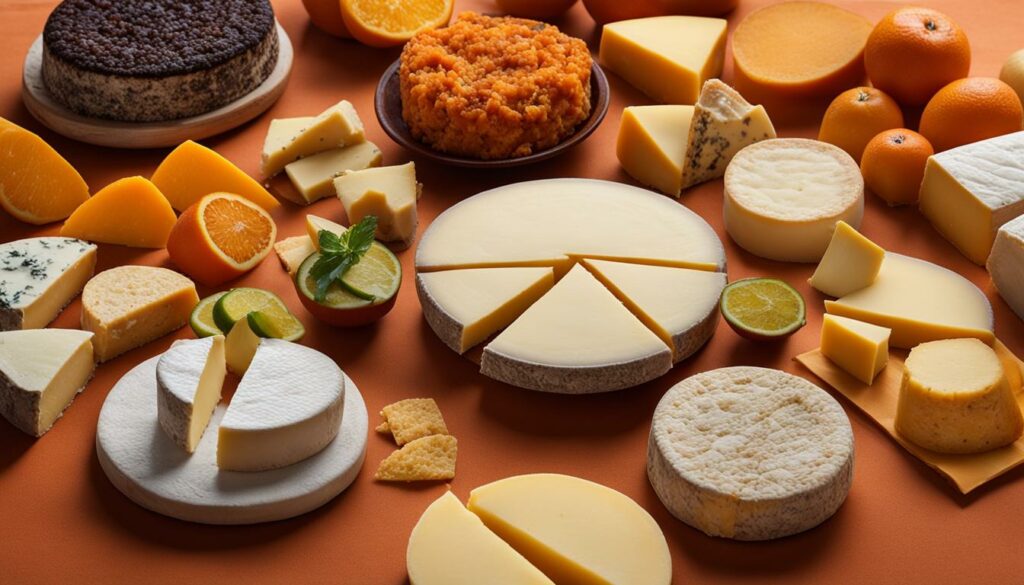
Mexican Melting Cheese (Semi-Soft)
When it comes to creating dishes with a luscious, melty texture, Mexican melting cheeses are a perfect choice. These semi-soft cheeses are known for their exceptional ability to melt, making them ideal for recipes like quesadillas, enchiladas, and grilled cheese sandwiches. Let’s explore some popular Mexican melting cheeses:
Manchego Cheese
Manchego Cheese is a semi-soft cheese made from sheep’s milk. It has a rich, buttery flavor and a smooth, creamy texture. Manchego melts beautifully, making it a versatile cheese for a variety of dishes.
Chihuahua Cheese
Chihuahua Cheese, also known as Queso Menonita, is a semi-soft cheese that originated in the Mexican state of Chihuahua. It has a mild, slightly tangy flavor and a stringy, elastic texture when melted.
Oaxaca Cheese
Oaxaca Cheese, also known as Quesillo, is a stretched-curd cheese with a delicate, buttery flavor. It is famous for its stringy, melty texture, making it a favorite choice for traditional Mexican dishes like chiles rellenos and tlayudas.
Asadero Cheese
Asadero Cheese is a semi-soft cheese with a mild, creamy flavor and a smooth, elastic texture. It melts beautifully, making it perfect for dishes like nachos, tostadas, and quesadillas.
Criollo Cheese
Criollo Cheese is a traditional Mexican cheese made from a mix of cow’s and goat’s milk. It has a smooth, creamy texture and a slightly tangy flavor. Criollo Cheese melts well and adds a unique touch to dishes like empanadas and Mexican-style grilled cheese sandwiches.
These Mexican melting cheeses offer not only a delightful taste but also a stringy, stretchy texture that makes them an excellent choice for dishes that require melted cheese. Experiment with these cheeses to add authentic Mexican flavors and create flavorful, gooey dishes that will impress your guests.

| Cheese | Origin | Flavor | Texture |
|---|---|---|---|
| Manchego Cheese | Spain | Rich, buttery | Creamy, smooth |
| Chihuahua Cheese | Mexico (Chihuahua) | Mild, slightly tangy | Stringy, elastic |
| Oaxaca Cheese | Mexico (Oaxaca) | Delicate, buttery | Stringy, melty |
| Asadero Cheese | Mexico | Mild, creamy | Smooth, elastic |
| Criollo Cheese | Mexico | Slightly tangy | Creamy |
Mexican Aged Cheese (Semi-hard or Hard)
Mexican aged cheeses are a delightful addition to any culinary experience. These semi-hard to hard cheeses are known for their crumbly texture and salty taste. They add a rich and robust flavor profile to a variety of dishes, making them a favorite among cheese lovers.
One popular Mexican aged cheese is Cotija Cheese, a firm and crumbly cheese with a sharp and salty flavor. It is often used as a finishing garnish, grated or crumbled over dishes like tacos, salads, and dips. Cotija Añejo is an aged version of Cotija Cheese, intensifying its flavor and adding a nutty complexity.
Cincho Cheese is another Mexican aged cheese that exhibits a range of flavors, from mild and buttery to sharp and tangy. It pairs well with fruits, bread, and wine, making it an excellent choice for charcuterie boards and cheese platters.
Enchilado Cheese is a hard, aged cheese coated in a layer of paprika and olive oil. This unique coating adds a distinct smoky flavor to the cheese, making it a popular choice for added depth in dishes like enchiladas and grilled sandwiches.
Chontaleno is an artisanal Mexican aged cheese with a semi-hard texture and a strong, slightly sharp taste. It is often enjoyed on its own or combined with other ingredients in various recipes.
Discover the boldness of Mexican aged cheeses:
- Enhance the flavor of your favorite dishes with Cotija Cheese, Cotija Añejo, Cincho Cheese, Enchilado Cheese, and Chontaleno.
- Add a crumbled or grated finishing garnish to tacos, salads, and dips.
- Enjoy these cheeses on their own or paired with fruits, bread, or wine.
- Experiment with Enchilado Cheese for a smoky and intense flavor in your enchiladas and grilled sandwiches.
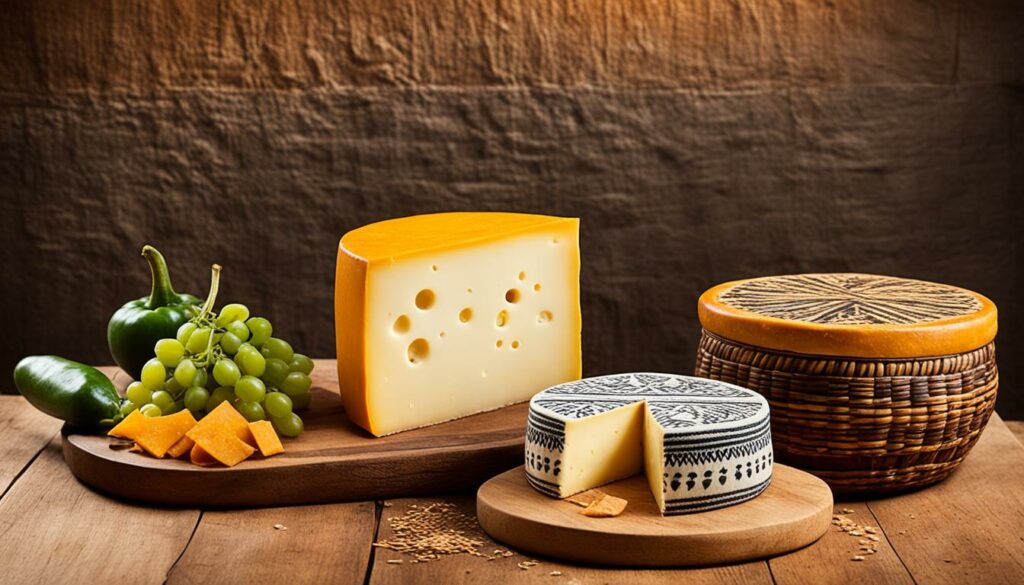
Experience the bold and unique flavors of Mexican aged cheeses through their crumbly texture, salty taste, and rich profiles. These cheeses will elevate your dishes with their distinct characteristics and add an authentic touch to any Mexican culinary creation.
Using Mexican Cheeses
Mexican cheeses are a culinary treasure that can add a burst of flavor and texture to your dishes. Whether you’re a cheese enthusiast or just starting your culinary journey with Mexican cuisine, these cheeses offer endless possibilities for creating delicious meals.
One popular Mexican cheese to experiment with is Queso Fresco (Adobera) cheese. This fresh cheese is versatile and pairs well with a variety of dishes. You can crumble it over salads or use it as a filling for enchiladas. Its mild flavor and creamy texture make it a delightful addition to any recipe.
If you’re looking to create gooey, cheesy delights like quesadillas or grilled sandwiches, Mexican melting cheeses like Oaxaca and Chihuahua are perfect choices. These semi-soft cheeses melt beautifully and provide that stretchy cheese pull we all love.
For a salty and tangy kick, aged Mexican cheeses like Cotija are the way to go. Add a sprinkle of crumbled Cotija on top of tacos, salads, or dips for an extra burst of flavor. This cheese works wonders in enhancing the taste of your favorite Mexican dishes.
To give you some recipe inspiration, here are a few ideas on how to use Mexican cheeses:
- Create a flavorful Mexican-inspired pizza using Oaxaca cheese as the base and topping it with your favorite ingredients like tomatoes, jalapeños, and cilantro.
- Make a refreshing and vibrant salad by combining Queso Fresco (Adobera) cheese with mixed greens, avocado, corn, and a zesty lime dressing.
- Prepare a comforting plate of enchiladas using Queso Fresco (Adobera) cheese as the filling, topped with a flavorful tomato sauce and baked to perfection.
- Add a twist to your favorite burger by melting Chihuahua cheese on top and serving it with a side of homemade salsa.
Remember, these are just a few ideas to get you started. Feel free to get creative and experiment with different Mexican cheeses in your favorite recipes. The unique flavors and textures they bring will elevate your dishes to new heights.

Start exploring the world of Mexican cheeses today, and let these artisanal delights inspire your culinary creations.
Conclusion
Queso Fresco (Adobera) cheese is a versatile and delicious ingredient that adds a unique flavor to Mexican cuisine. Its rich history, dating back to prehispanic times, and the wide range of Mexican cheese varieties available today make it an essential part of any kitchen. Whether you’re a fan of the mild and fresh taste of Queso Fresco or the gooey melt-in-your-mouth goodness of Oaxaca cheese, there is a cheese for every palate.
From traditional dishes to modern creations, Queso Fresco (Adobera) cheese can be used in a myriad of ways to enhance your cooking. It can be crumbled or grated on top of dishes like enchiladas and salads, or melted into quesadillas and grilled sandwiches for that perfect cheesy indulgence. The salty and crumbly aged Mexican cheeses, like Cotija, can be simply sprinkled over tacos, salads, and dips to add a burst of flavor.
To explore the true flavors of Queso Fresco (Adobera) cheese, take inspiration from the recipes provided in this guide. From classic Mexican dishes to innovative fusion recipes, there are endless possibilities to create mouthwatering meals. So, grab a block of Queso Fresco (Adobera) cheese, let your creativity flow, and delight your taste buds with these delicious recipe ideas.
FAQ
What is Queso Fresco (Adobera) cheese?
Queso Fresco (Adobera) cheese is a type of Mexican cheese that is soft and white in color. It is a fresh cheese with a mild flavor and a crumbly texture.
How is Queso Fresco (Adobera) cheese different from other Mexican cheeses?
Queso Fresco (Adobera) cheese is softer and milder in flavor compared to other Mexican cheeses. It is often used as a topping or filling in various dishes.
What are the different types of Mexican cheeses?
Some of the different types of Mexican cheeses include Queso Fresco, Queso Blanco, Panela Cheese, Tenate Cheese, Adobera Cheese, Requesón, Crema Mexicana, Manchego Cheese, Chihuahua Cheese, Oaxaca Cheese, Asadero Cheese, Criollo Cheese, Cotija Cheese, Cotija Añejo, Cincho Cheese, Enchilado Cheese, and Chontaleno.
How are Mexican cheeses used in cooking?
Mexican cheeses can be used as toppings, fillings, or ingredients in a variety of dishes such as enchiladas, salads, soups, quesadillas, and grilled cheese sandwiches. They add unique flavors and textures to elevate your cooking.
Can Queso Fresco (Adobera) cheese be melted?
Queso Fresco (Adobera) cheese is generally not a melting cheese and is best used as a topping or filling in cooked dishes. However, some people may choose to melt it slightly for certain recipes.
Where can I buy Mexican cheeses?
Mexican cheeses are commonly available in Mexican grocery stores, specialty cheese shops, and some mainstream supermarkets. You can also find them online through various retailers.
Are Mexican cheeses suitable for vegetarians?
Most Mexican cheeses are suitable for vegetarians as they are made from dairy products and do not contain animal rennet. However, it is essential to check the label or ask the manufacturer to be sure.
What are some popular recipes using Queso Fresco (Adobera) cheese?
Some popular recipes using Queso Fresco (Adobera) cheese include enchiladas, salads, tacos, quesadillas, and stuffed peppers. You can find delicious and creative recipe ideas in our Queso Fresco (Adobera) cheese guide.
Can I substitute Queso Fresco (Adobera) cheese with other cheeses?
If you cannot find Queso Fresco (Adobera) cheese, you can substitute it with other fresh or mild cheeses like Queso Blanco or Panela Cheese. However, keep in mind that the flavor and texture may differ slightly.





